This article may contain affiliate / compensated links. For full information, please see our disclaimer here.
Once you are in Tunisia, you should spend at least one day in the capital, Tunis. Here you find the best things to do in both the medina and the modern part.
Despite its expansive size with 2.7 million people living in Greater Tunis, apart from the traffic jams of the peak hours and that the traffic rules are widely ignored by locals, Tunis is a calm, pleasant city with no skyscrapers. The overwhelmingly white-painted houses seem elegant from a distance, but as you discover the city, it is not as clean as it appeared earlier. Since Tunis lies along the Mediterranean Sea, you can quickly get to one of the beaches as well.
Check this 5, 7 and 10 days road trip itinerary to plan your trip after Tunis
- How to get around in Tunis?
- Where to eat in Tunis?
- Where to stay in Tunis?
- Best local tours in Tunis and day trips from Tunis
- Is it possible to spend a weekend in Tunis?
- Things to do in the modern city (Ville Nouvelle) of Tunis
- Attractions not to miss in the medina of Tunis
- Other city guides of Arab countries
Tunis was founded in 698 CE as one of the first Arab Islamic towns in the Maghreb and is one of the best-preserved medieval Arab-Muslim cities in the world.
Tunis has two distinct parts: the medina and the nearby modern district (ville nouvelle), created by the French colonists during the 19th century.
The Medina of Tunis, a UNESCO World Heritage Site, is known for its unique keyhole-shaped colorful doors. Once, it was among the wealthiest and greatest cities in the Arab world. Strolling around in the labyrinth of alleys, you finally end up at the Zitouna mosque, the most important attraction.
You have probably never seen so many cats as in Tunis. But in the whole of Tunisia, cats are a ubiquitous sight.
The modern part has a range of colonial buildings from the French period, with several cozy restaurants, French-style cafés, and patisseries along the avenue Habib Bourguiba aligned with palm trees.
Medina
In every city along the coast, you will find a medina, an old town. These are usually the most exciting parts of the cities, and all have some unique character. The medina of Tunis is known for its colorful doors, the one in Sousse is extremely lively, the one in el Kef is untouched, the one in Kairouan is untouched and authentic, the one in Sfax lacks all the tourist things, and with its shabby buildings, it’s a journey into the past. Mosques, hammams, holy shrines, caravanserais, and the souk (bazaar in the Arab world) are also inside the medina. The buildings were constructed according to the same concept, around courtyards inspired by the Prophet Mohammed’s house in Medina. Once you enter the alleys, it seems chaotic, and you probably lose your orientation in the narrow streets that provide shadow during the hot days. But this is the best way to discover it: going from one corner to the other until you reach the Grand Mosque, which usually occupies a central place. Medinas are often surrounded by fortified walls used to serve defense purposes, and their gates (bab) used to regulate the entry.
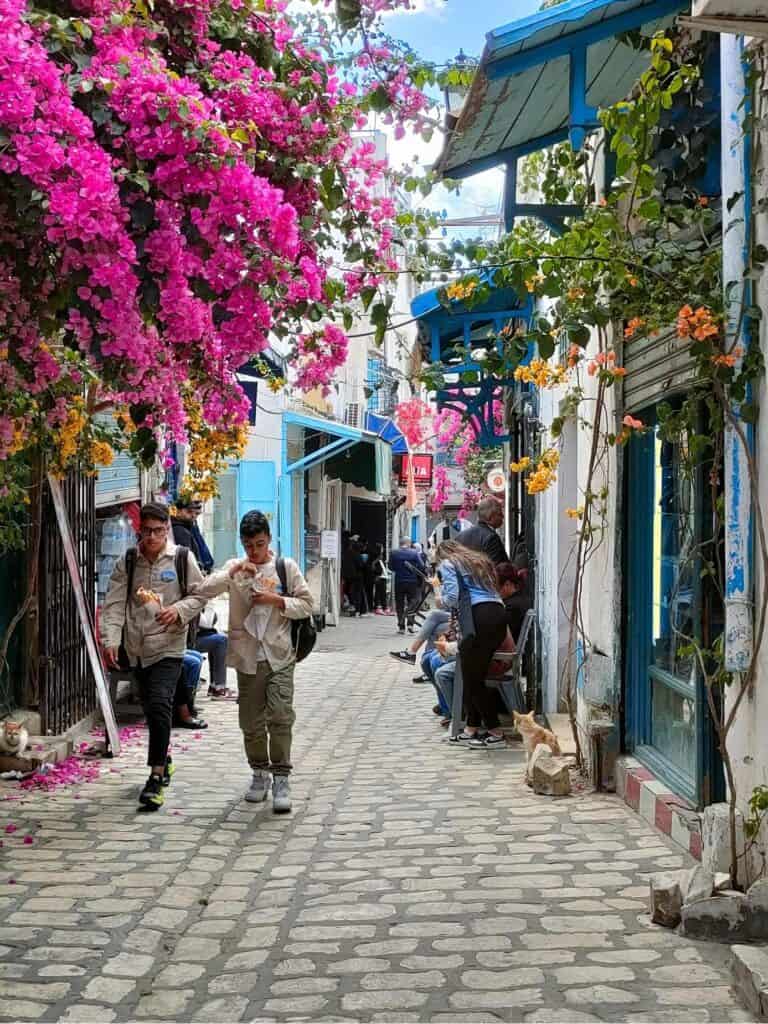
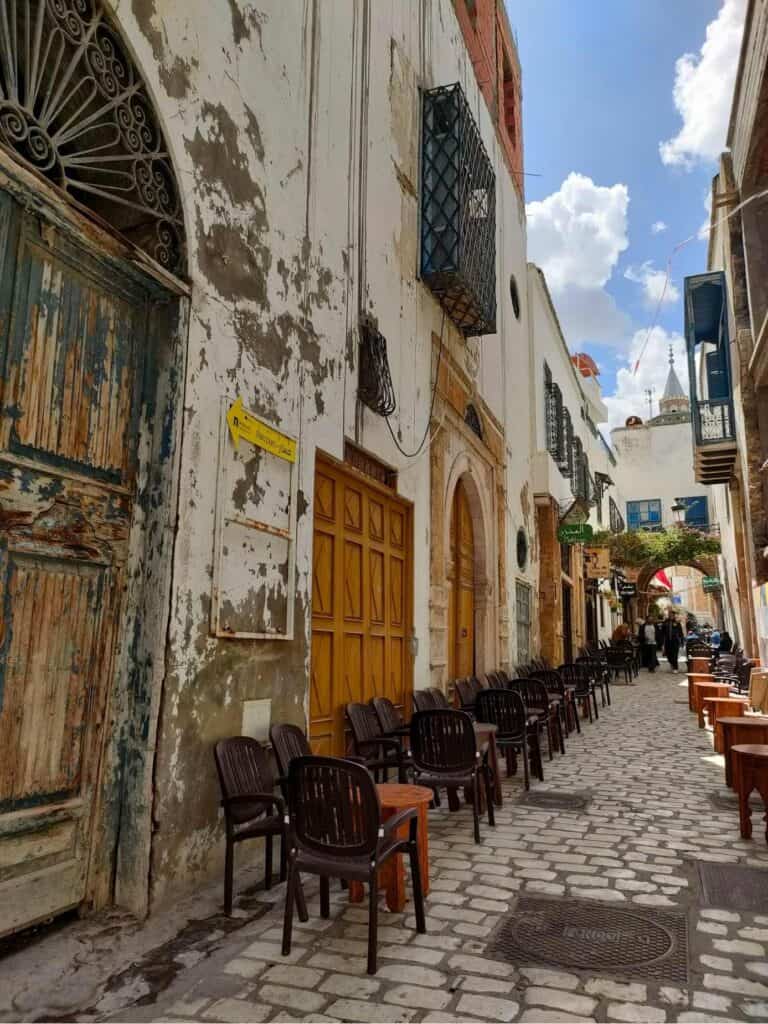
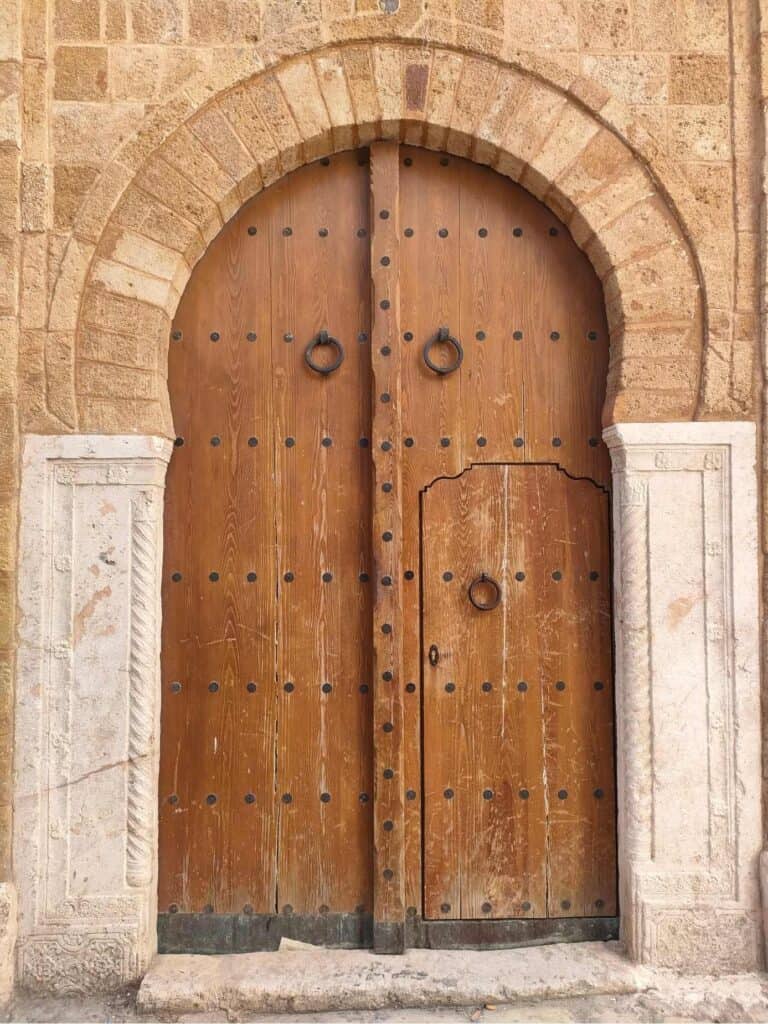
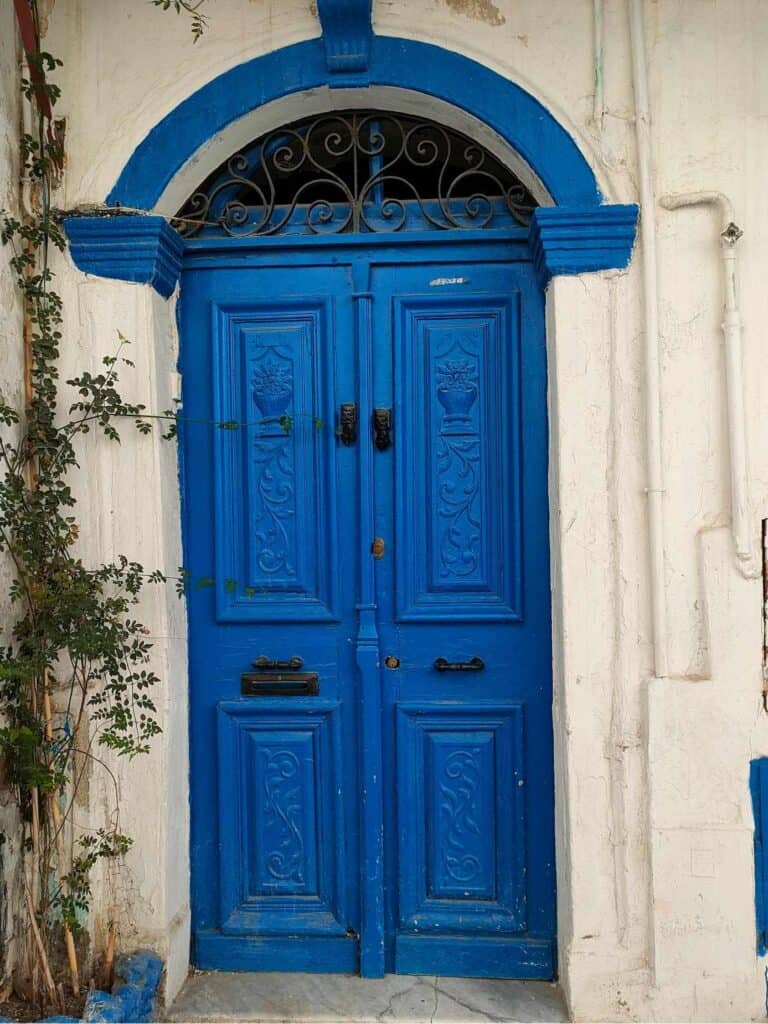
How to get around in Tunis?
You can reach most of the attractions on foot as the old and attractive modern parts are close to each other. Although Tunis has a good tram network (métro légere), for a traveler, a taxi may be the best way to get around in Tunis.
Download the Bolt App and order a taxi through that. In this way, you don’t need to worry about being overcharged for your ride and it makes it easy if you don’t speak the local language.
TGM
The TGM is a suburban train line that connects central Tunis with the suburbs (La Goulette, Carthage, Sidi Bou Saïd, and La Marsa), all located along the line. The entire length of the TGM takes 35 minutes. Tickets cost less than a dollar, which is the best way to get to these places.
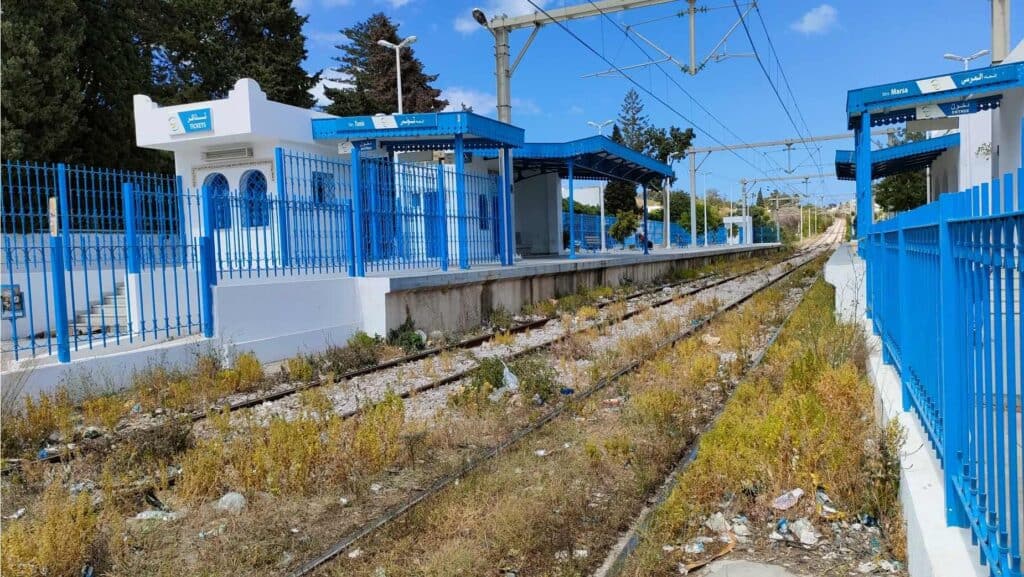
Where to eat in Tunis?
“Dar El Jeld” is a must-visit in the Medina of Tunis. The traditional setting and delicious food provide a real feeling of Tunisian culture.
Fondouk el Attarine: a former caravanserai converted into an elegant restaurant in 2003 with a great atmosphere in the heart of the medina.
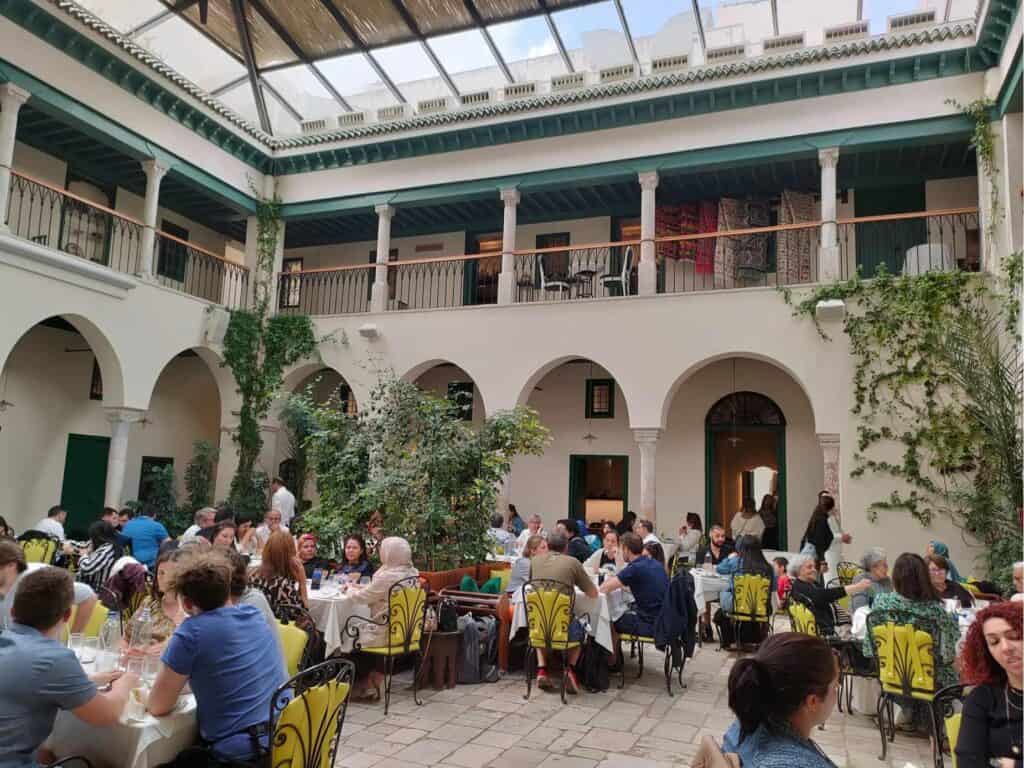
Where to stay in Tunis?
If you want to stay in traditional houses, look for the Dars, traditional Tunisian houses converted into hotels. They are available in different budgets and are similar to the Riads in Morocco.
Check this 5, 7 and 10 days road trip itinerary to plan your trip after Tunis
Low budget /hostels:
Dar Ya – is a traditional Tunisian house with colorful tiles, an inner courtyard, and a rooftop with a perfect location in the medina. They have private rooms and single beds in a dormitory, but even private rooms have shared bathrooms.
Hotel al Karmel: I stayed in this newly renovated low-budget hotel outside but within walking distance from the medina. Rooms have a private bathroom and balcony, and breakfast is included in the price.
Mid-range:
Top-end hotel:
Best local tours in Tunis and day trips from Tunis
Even if I mostly travel individually, I always take local tours that help me better understand the place instead of relying on a guidebook or just walking around. This is also a great way to meet somebody who grew up there and even get tips for the rest of the trip.
I went on a walking tour that showed both the old and the new part of the city A Tale of Two Worlds: Exploring the Contrasts of the Medina and Avenue Habib Bourguiba by Guruwalk, starting from the Clock tower, which was erected to commemorate the former President Ben Ali’s assumption to power on 7th November 1987 (7th November) at the Avenue Habib Bourguiba near the former president Habib Bourguiba’s statue riding triumphantly on a horse.
Check out our local tours in and around Tunis:
Visit the archeological sites of Carthage with bike
Private street food tasting in Tunis medina
Full-day sightseeing in Tunis with lunch
Day trip to Kairouan, El Jem, Sousse
Sidi Bou Said, Carthage, and the Medina all in one day
Is it possible to spend a weekend in Tunis?
Since Tunisia is only a 2-3 hour flight from most European cities, spending only a weekend in Tunis is easily possible. However, you only get a good insight into a country by discovering the countryside.
Things to do in the modern city (Ville Nouvelle) of Tunis
Avenue Habib Bourguiba was the site of the protests that brought down Zine al-Abidine Ben Ali in 2011. Apart from the former president, Ibn Khaldūn, one of the most outstanding social scientists of the Middle Ages, also has a statue nearby.
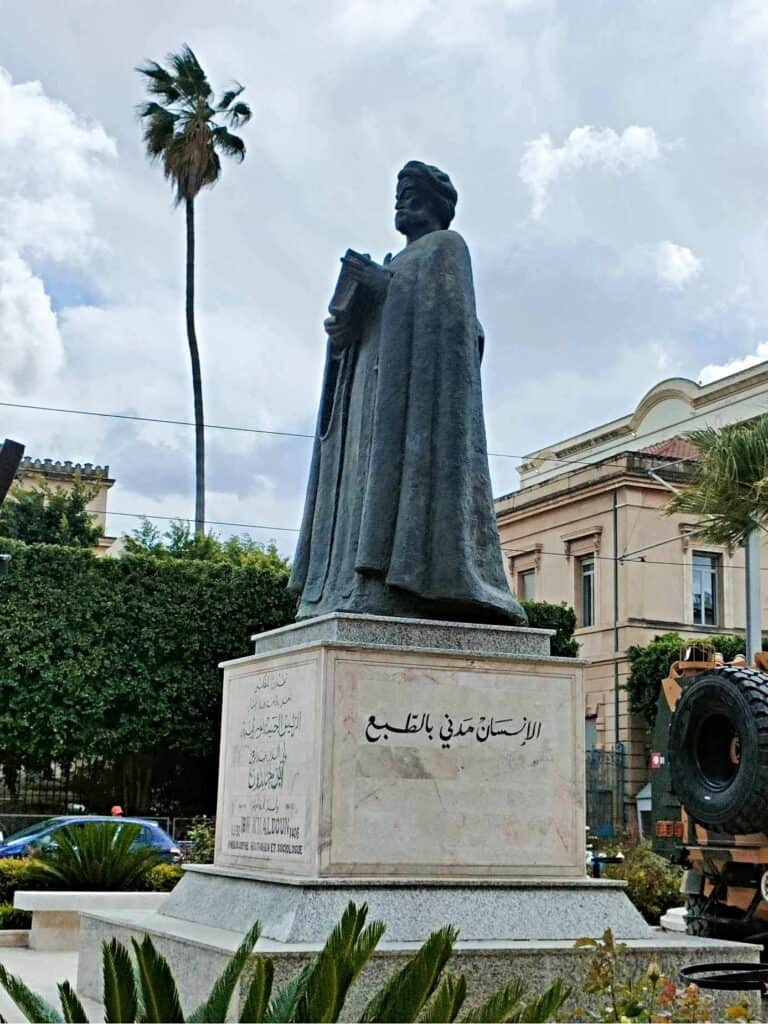
Along the Avenue Habib Bourguiba stand the Cathedral of St. Vincent de Paul, the Hotel Majestic, the National Theater, and the tallest building in Tunisia, the Hotel Africa.
The Cathedral of Saint Vincent de Paul, built in the 19th century, has a unique Moorish, Gothic, and Neo-Byzantine architectural style.
Opening Hours: Daily: 8am-12pm / 3-5pm (Sep-Jun); 8am-3pm (Jul, Aug)
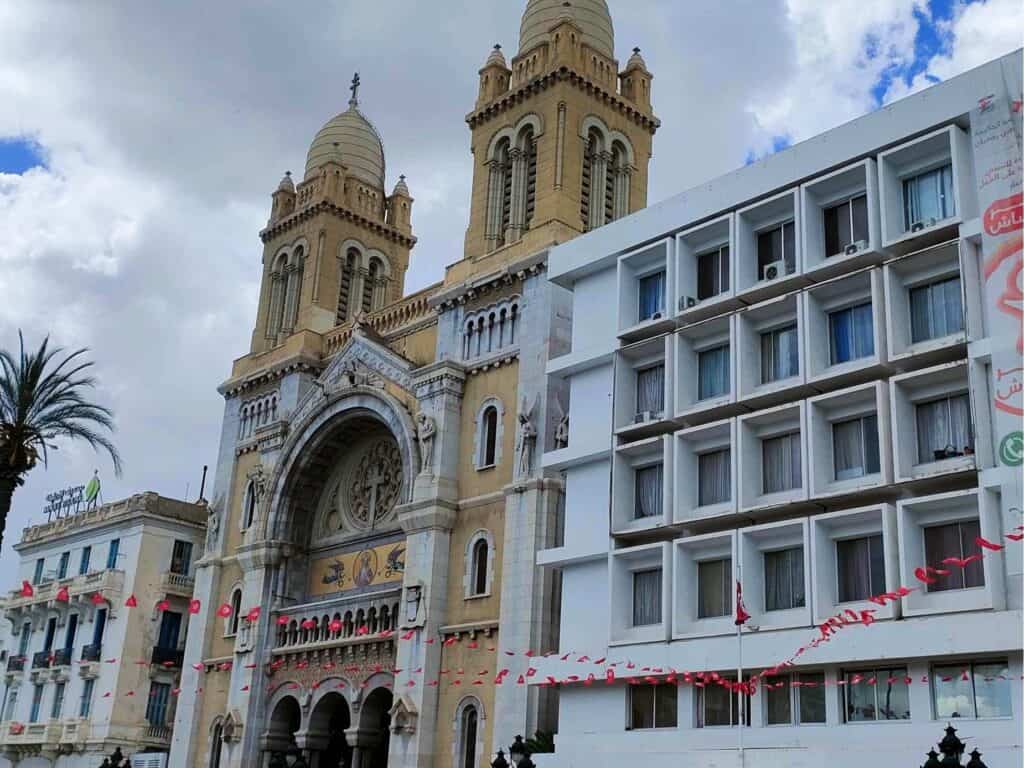
We made a round in the central market (Marché Central) with all kinds of fish and vegetables, then continued our tour in the old city, the medina. Our guide stopped to show some things sold in the souk, for example, jewelry used by the Berbers, and we tasted some local sweets. We didn’t miss visiting the Zitouna mosque and the two famous rooftop viewpoint.
I recommend this tour with Riadh, a young Tunisian who is very enthusiastic about introducing his country. (You can also contact him on WhatsApp: +216 22735875)
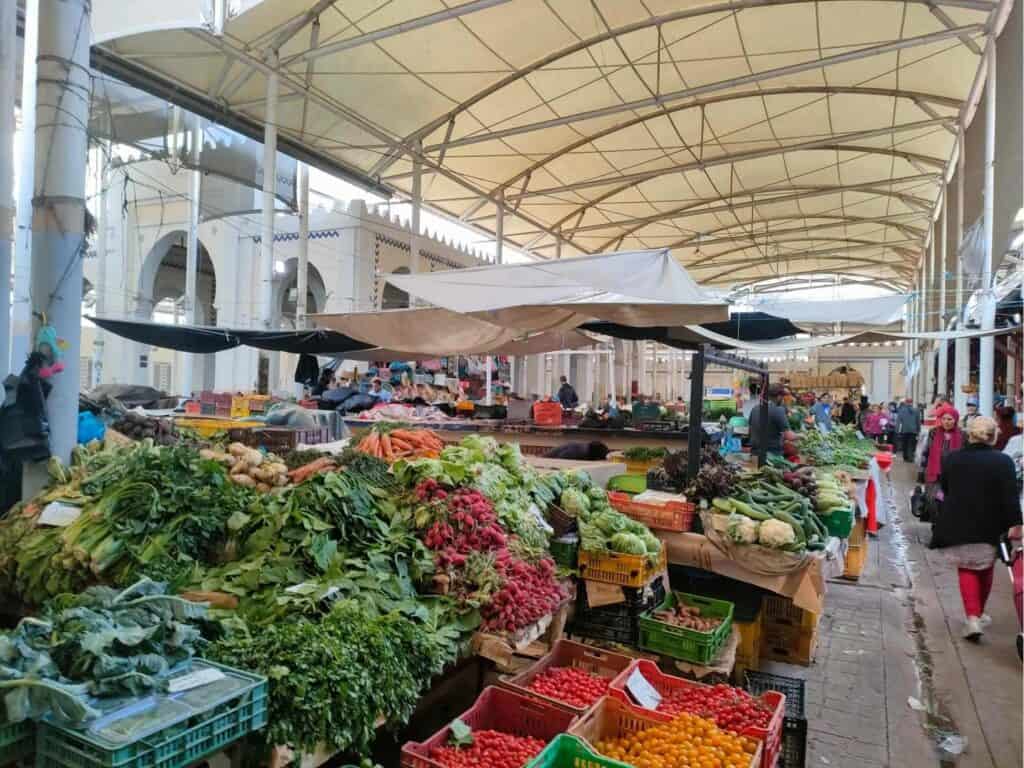
Attractions not to miss in the medina of Tunis
Bab Bhar (Porte de France or French Gate)
The freestanding arch is the entrance to the medina if you arrive from the avenue Habib Bourguiba.
Viewpoints in the medina
There are two famous panorama spots in Tunis next to each other: one with a café on the top (Café Panorama) and another one without a café, but as it is a former palace of the Bey, the ruler of Tunisia, you can check his royal bed. In both cases, you will go through the multistorey shop selling everything from carpets to paintings, mosaics, handicrafts, and all types of souvenirs, but you don’t need to pay an entrance fee to enjoy the view. This is one of the most photographed places in Tunis and offers a great view of the Zitouna mosque and the entire city.
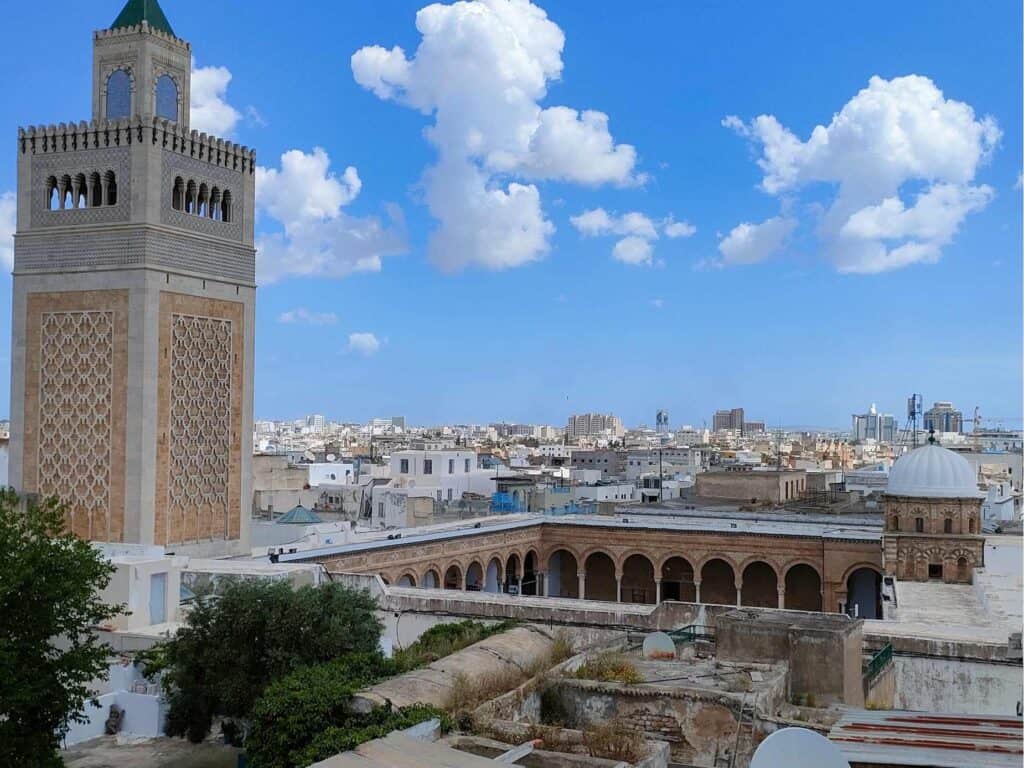
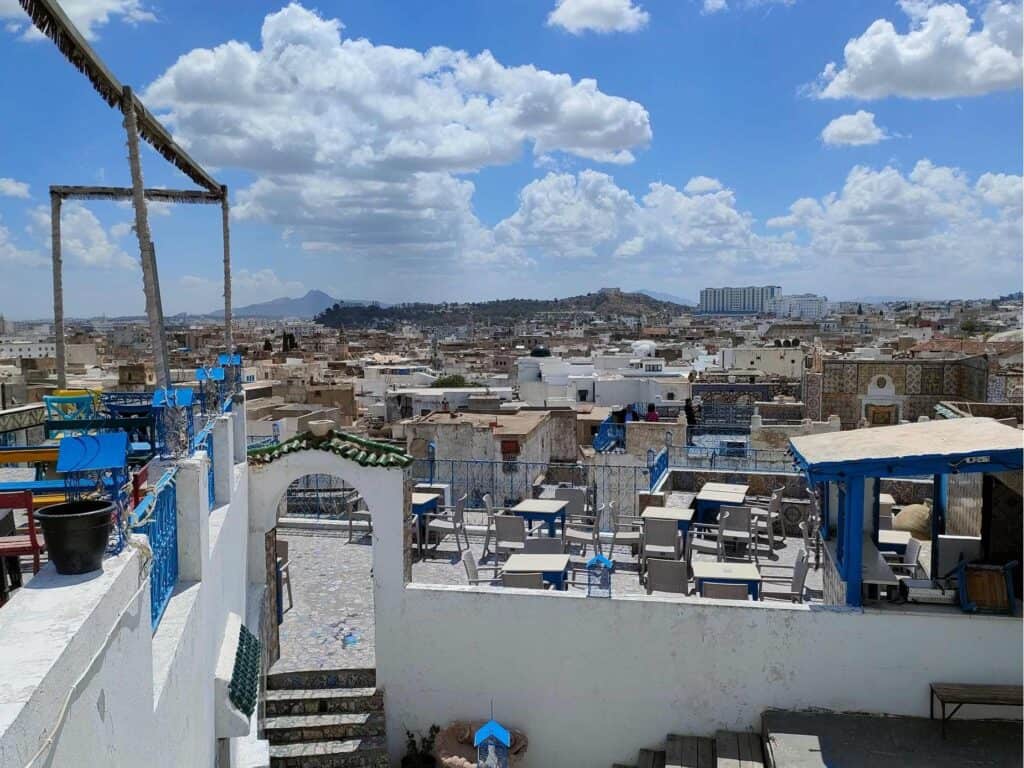
Al-Zaytuna (Zitouna) mosque
It is the second oldest and most important mosque in Tunisia after the Mosque of Uqba in Kairouan, most probably built at the end of the 7th and beginning of the 8th century, but the Aghlabid rulers rebuilt both in the 9th century. It was continuously extended afterwards. Some of its columns were brought from Carthage.
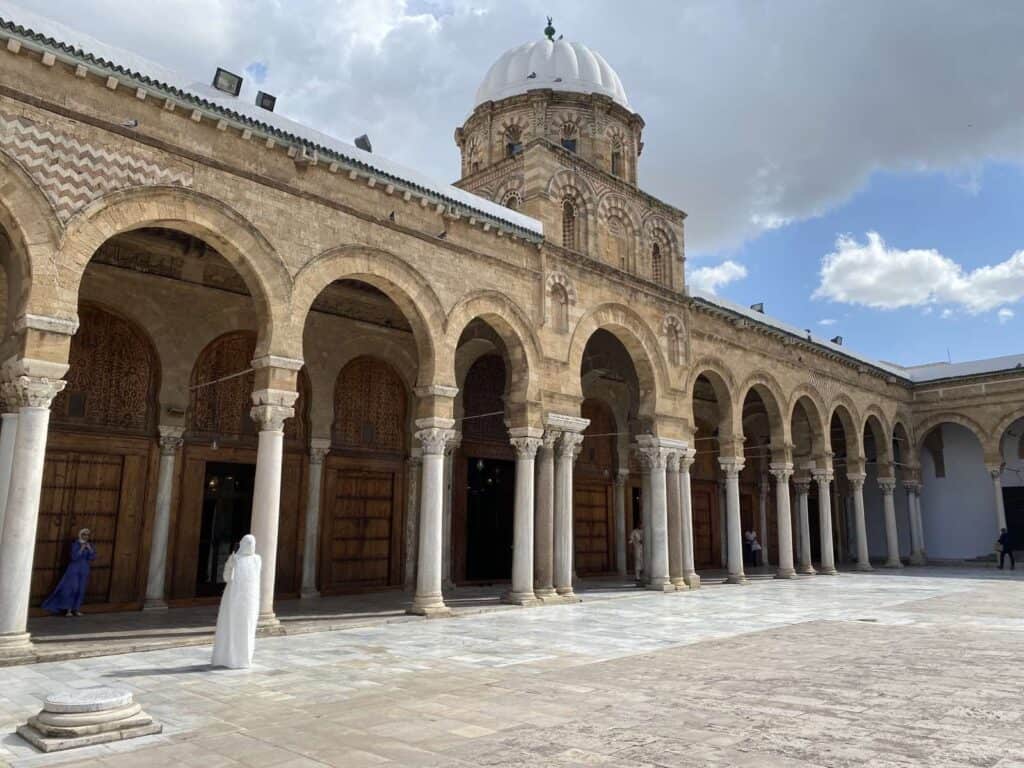
The mosque was unique in giving space to one of the first and most influential universities in the history of Islam, where countless Muslim scholars, like the above-mentioned Ibn Khaldun, graduated over a thousand years. Al Zaytuna was once a major Islamic center of learning in North Africa and attracted students worldwide.
Zaytuna was attended by students from mainly the wealthiest families of Tunisia until the 20th century, after which it was accessible to the less privileged. Zaytuna was more than a university. It became a center of resistance against French colonial rule as an Islamic and Arab cultural center. Even some Algerian Nationalist leaders studied here.
Check this 5, 7 and 10 days road trip itinerary to plan your trip after Tunis
Zaytuna lost its importance after Tunisia gained independence from France, and the University of Tunis opened in 1960. President Bourguiba decided to relegate it to being a theological college for the University of Tunis. During the revolution of 2011, protestors demanded that it becomes an independent educational institution again.
Opening hours: it opens at noon
How to dress up: dress modestly and cover your hair with a scarf. As a non-Muslim, you are theoretically prohibited from entering the main praying room. The women’s part is relatively small, and you cannot see the main hall from there. So, it is enough to see the courtyard.
The souk
Get lost in the alleys of the Arabic bazaar, which has different sections. There are several souvenir shops, and the shopkeepers will try to take you to their shops and sell something. They are pushy but still bearable compared to some other countries, like Egypt.
The unique red hats are prepared and sold in the Grand Souq des Chechias. These skullcaps were initially used as the basis for the turban. Having been exported worldwide centuries ago, it was an important economic source. There are still some shops, although I expected to see the hats in piles, which was not the case.
The Tourbet el-Bey
This is a royal mausoleum, the resting place of almost all the rulers, princesses, and ministers of the Husainid dynasty. One of their rules ordered its construction in 1770. The rooms and patios contain the tombs of 165 different beys who governed Tunisia from 1759 to 1942. It is decorated with intricate tiles and stuccos and topped with green domes.
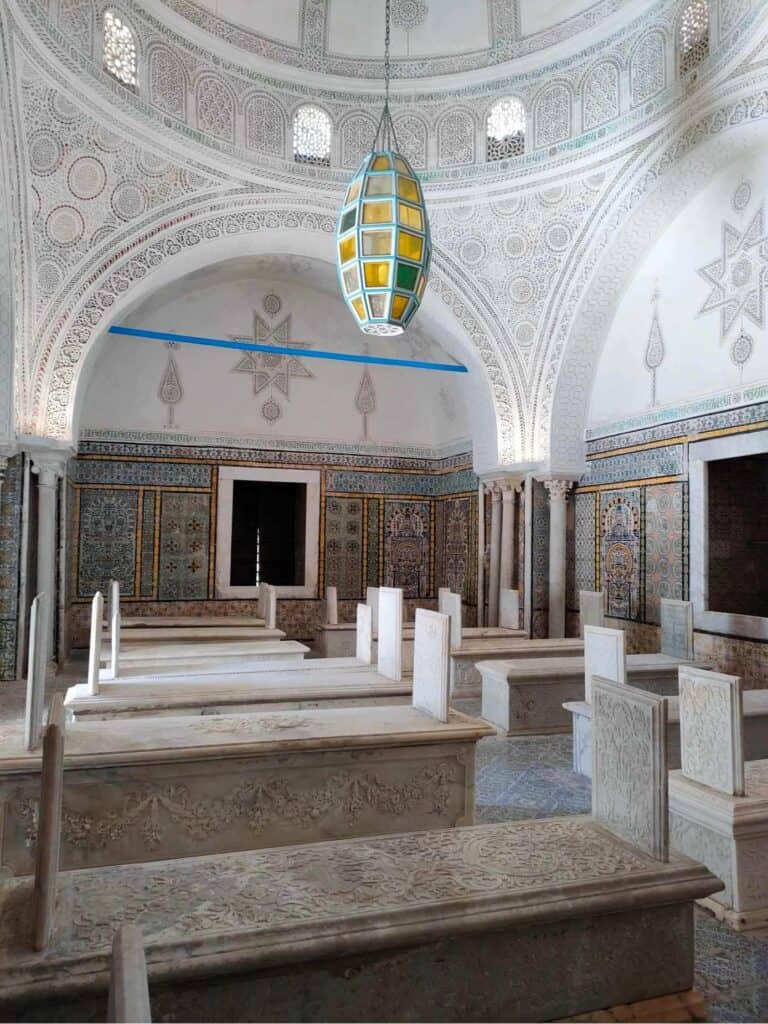
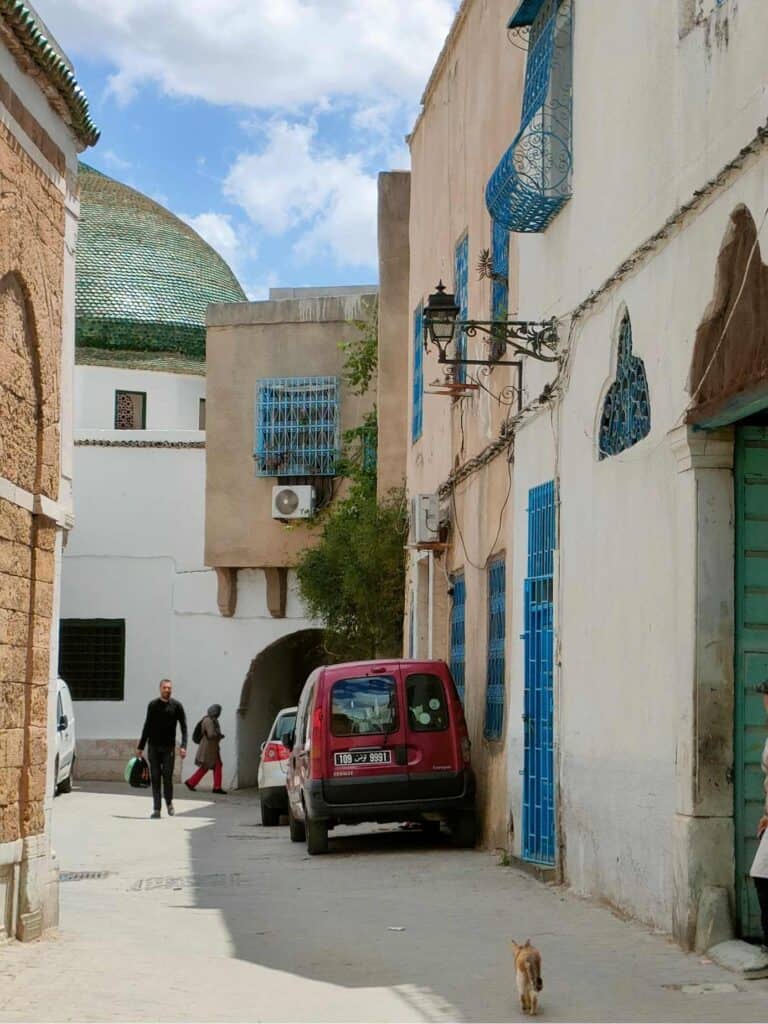
Synagogue of the Medina:
The synagogue in the former Jewish quarter of the city is, unfortunately, shamefully neglected. Even garbage is thrown in front of the entrance. Tunisia had a significant Jewish community, but when Israel declared its independence, 20 000 of them left the country, although Jews had lived in Tunisia since Roman times.
However, you can check out the Grand Synagogue of Tunis, located around 20 minutes walk from the medina. It was designed by a French-Tunisian architect and had a huge Star of David on its façade.
You probably cannot visit it just have a look from outside. Usually, the guards and the Jewish community don’t even let you take a photo of that.
The most important Jewish community, approximately 100 people, lives on Djerba island, where the annual Jewish festival attracts thousands of pilgrims from Europe, Israel, and the US every May. The festival takes place on the 33rd day of the Passover Jewish festival when Israelites escaped slavery in Egypt.
The Synagogue of Al Ghriba is the biggest in Africa, and both Jews and Muslims attend it, symbolizing a peaceful coexistence.
Dar Lasram
It is a fine example of attractive mansions in the medina from the 18th century.
Apart from the above, you should just stroll around the streets of the medina and check out some of the shrines, palaces of beys (rulers during the Ottoman period), courtyards, and other pretty gems, the most interesting ones are Dar Othman (built by Othman Bey, the wealthy businessman was also the governor of Tunis) Dar Ben Abdallah (the most beautiful former palace in the medina from the 18th century) and Zaouia Sidi Mahrez (the final resting place of Sidi Mehrez, Tunis’ patron saint. Women offer prayers here to be endowed with a husband or children).
The Palais Khereddine (Museum of Tunis) stands on a square, and it is worth having a quick look.
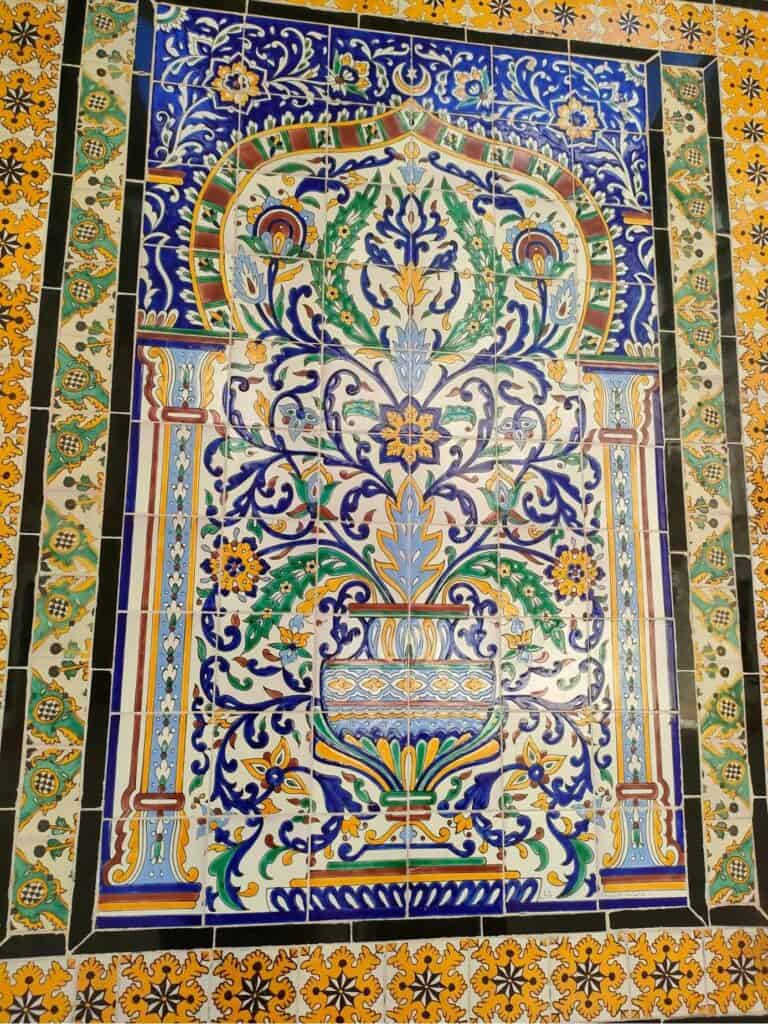
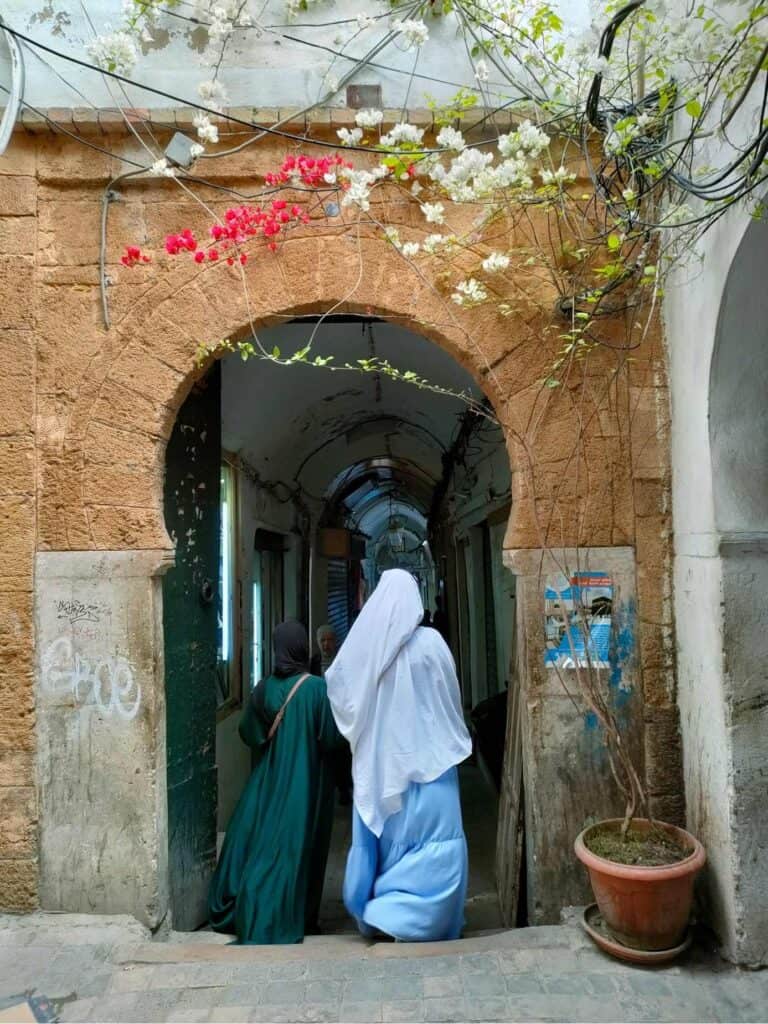
Bardo museum
Important: Unfortunately, it has been closed for three years because it is in the same complex as the Tunisian parliament, which President Kais Saied suspended in July 2021. When we were there, they said it would open in 2023 May, so it could reopen soon.
The museum houses the world’s best collection of mosaics that once adorned villas of wealthy people dating to the 2nd and 6th centuries. The precious collection is housed in the former palace of one of the “beys,” originally built in the 13th century and converted into a museum in 1888. It is the second richest collection in Africa after the Egyptian Museum.
These mosaics created with an African touch adorned the places you see in the archeological sites of Dougga, Carthage, Bulla Regia, and all around Tunisia, so it will help you imagine their original appearance.
Check this 5, 7 and 10 days road trip itinerary to plan your trip after Tunis
The Roman mosaics reveal people’s daily life and display mythological figures, hunting scenes, everyday life, and Roman emperors. You can learn about the burial practices of the Phoenician, Punic, Roman, and early Christian periods through the elaborately decorated sarcophagus and gravestones.
The museum also houses a collection of ceramics, metalwork, calligraphy, and textiles as examples of Islamic art traditions.
Some of the most notable pieces of art in the museum are the
– Hermaion d’El Guettar: probably the world’s oldest spiritual monument
– 3rd-century BC stele from Carthage showing a priest carrying a child, possibly to be sacrificed
– Statues from Bulla Regia, starring Apollo
– Formal reception rooms furnished in the 19th-century Husseinite style
– Part of large statues that depicted wealthy people’s palaces
How to get there?
The Bardo is located 4 km from the medina. You can get there by métro léger (Tunis’ tram network) to Le Bardo station on line 4. It’ll take at least a few hours to visit the museum.
Other city guides of Arab countries
Tunis is a pleasant Arab city with a Westernized mindset but an oriental charm with a colorful medina, colonial buildings, excellent restaurants to try local cuisine and a bustling nightlife. You can discover the nearby archeologic site, Carthage, and the blue-white village, Sidi Bou Said, which makes you feel being in Greece. Tunis is only a short flight from Europe, which makes it also ideal for a weekend holiday. However, there is so much more to see in Tunisia. Check out the one-week travel itinerary as well.

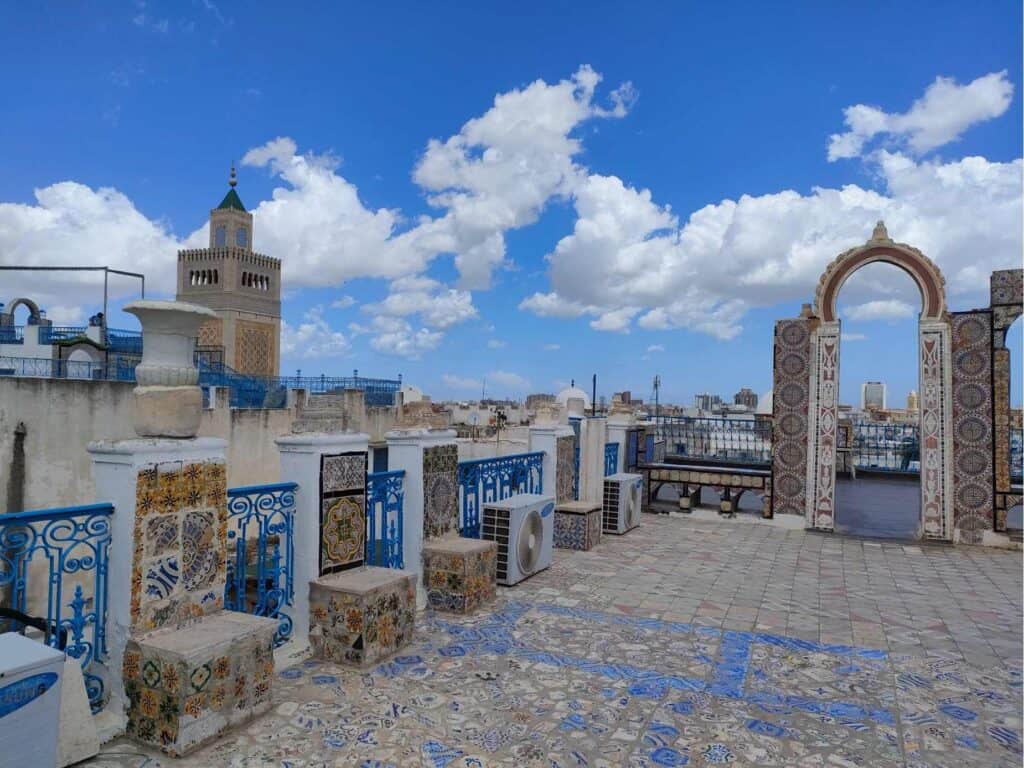

Hi there! After the terrorist attack in March 2015, I’m afraid to even think of going to Tunisia, but I really want to! What’s your opinion on the safety now in 2023-2024? We’ll be in Nice France for several days and I’m toying with the idea of spending two nights and one day in Tunis. Pls advise. Love your article by the way. Thank you so much!
Hi!I think there is no problem to make a trip to Tunis. Since 2015 a lot has changed and there are many tourists again in Tunisia. There was one incident during my stay in Djerba releated to the Jewish festival with attacks at the synagogue against Jewish people. I’m sure you would enjoy your stay in Tunis and it doesn’t involve bigger risk than some European countries. Hopefully, the Bardo museum will be opened by the time you go there!